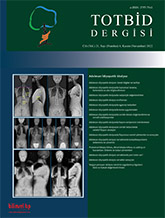
Despite tremendous advances in cross-sectional imaging in recent years, radiography remains the mainstay in the diagnosis and evaluation of scoliosis. Idiopathic scoliosis is a diagnosis of exclusion. Radiography is the first choice for imaging idiopathic scoliosis, both to confirm the diagnosis and to rule out possible secondary causes. Scoliosis can be defined radiographically as the presence of one or more lateral rotatory curves of the spine in the coronal plane. Although it is defined as a side-by-side deformity, it is a three-dimensional (3D) rotational deformity. Technical factors, measurement error, and knowledge of measurement techniques are important in comparing serial radiographs and affect surgical decision making. This article aims to explain the general concepts in radiographic evaluation of the spine in adolescent idiopathic scoliosis as a framework.